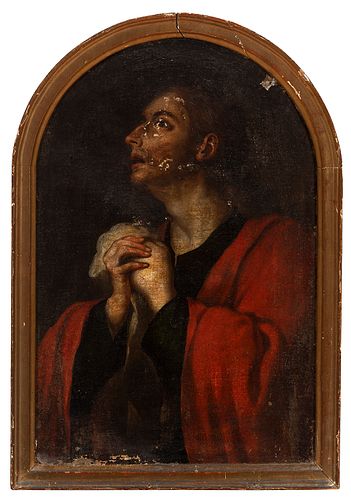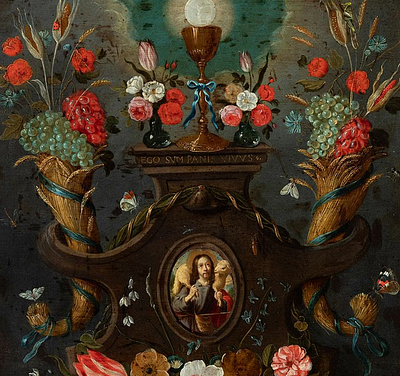Spanish school; 17th century, after models by QUENTIN METSYS (Belgium, ca. 1466 - 1530). "San Juan at Calvary". Oil on canvas. Antique re-colouring.
Lot 5
About Seller
Setdart Auction House
Carrer Aragó 346
Barcelona
Spain
Setdart Subastas was born in 2004 and is currently the first online art auction in Spain with solidity, prestige and reliability guaranteed by our more than 60,000 users. Setdart has a young, dynamic and enterprising team ready to successfully manage the purchase and sale of art works through custom...Read more
Estimate:
EUR€1,500 - EUR€2,000
$1,578.95 - $2,105.26
Absentee vs Live bid
Two ways to bid:
- Leave a max absentee bid and the platform will bid on your behalf up to your maximum bid during the live auction.
- Bid live during the auction and your bids will be submitted real-time to the auctioneer.
Bid Increments
| Price | Bid Increment |
|---|---|
| EUR€0 | EUR€10 |
| EUR€200 | EUR€25 |
| EUR€500 | EUR€50 |
| EUR€1,000 | EUR€100 |
| EUR€3,000 | EUR€200 |
| EUR€5,000 | EUR€500 |
| EUR€10,000 | EUR€1,000 |
| EUR€20,000 | EUR€2,000 |
| EUR€50,000 | EUR€5,000 |
About Auction
By Setdart Auction House
Sep 21, 2021
Set Reminder
2021-09-21 10:00:00
2021-09-21 10:00:00
America/New_York
Bidsquare
Bidsquare : 21st September - ARAS JÁUREGUI Private Collection - Old Masters, 19th & 20th Century
https://www.bidsquare.com/auctions/setdart-auction-house/21st-september---aras-j-uregui-private-collection---old-masters-19th-20th-century-7429
Setdart Auction House sofia@setdart.com
Setdart Auction House sofia@setdart.com
- Lot Description
Spanish school; 17th century, after models by QUENTIN METSYS (Belgium, ca. 1466 - 1530). "San Juan at Calvary". Oil on canvas. Antique re-colouring. It presents faults in the painting and in the frame. Needs cleaning. Measurements: 72 x 47 cm; 79 x 84 cm (frame). Both the format of the piece and the subject matter indicate that this work is part of a larger group representing Christ's Calvary, so the image of Jesus on the cross and the Virgin Mary would be missing. In this particular case, Saint John, wearing his usual red tunic, looks towards the sky, in a clement attitude, probably towards the work that depicts the portrait of Christ mentioned above. The saint clasps his hands, in which he holds a handkerchief, close to his chest, thus adopting a very devotional gesture that reveals his fervour and faith. In terms of its technical characteristics, the painting has certain similarities with the work of Quentin Metsys, who produced several paintings on the theme of Calvary. As the founder of the Antwerp school, characterised by the achievement of a balanced synthesis between Flemish tradition and the influence of the Italian Renaissance, Quentin Metsys was a highly influential figure with a number of disciples and followers. He was born in the city of Louvain, although he developed his career in Antwerp. He cultivated religious subjects and portraiture, the two most popular genres of the period, and his works often had a clear satirical undertone. He was trained in the language of the Flemish Primitives, which prevailed during his formative years. Thus, the intense religious sense, sumptuous colour and meticulous detail remained constants in his style, although with the passing of time the influence of Leonardo da Vinci became apparent and his language became increasingly delicate and calm. It is thought that he may have become acquainted with Leonardo's work through the engravings that were circulating in Flemish artistic circles at the time, often by local engravers. In fact, his "Madonna and Child with Lamb" (1513, Poznan, National Museum) is clearly inspired by the Italian's "Madonna and Child with Saint Anne" (ca. 1503, Paris, Louvre). Historians also consider a possible trip by Metsys to Italy, although there are no surviving documentary sources to confirm this. In fact, we know little reliable information about his life today, especially about his early life. The son of a blacksmith, it is said that he abandoned his family trade for painting as he considered that art to be more elevated. In any case, there is no documentation of the painters' guild in Louvain prior to 1494, so there is no concrete evidence that Metsys became a master there. However, it is generally accepted by historians that he must have begun his training there, as he is not recorded in Antwerp as an apprentice. We do know from later sources that he had his own workshop in Antwerp, but only four apprentices were trained there: Adrian van Overbeke, Willem Muelenbroec, Eduart Potugalois and Hennen Boeckmaere, all of whom were registered in his workshop between 1495 and 1510. It is now thought that Joachim Patinir also spent part of his formative years in Metsys' workshop and that he collaborated with the master by painting landscapes for his works. The lack of information about Matsys in the Antwerp guild in the following years suggests that he may have travelled to Italy and other cities in the Low Countries. In any case, the foreign influence on his language can be deduced from his paintings and is considered an important part of his training at a late date in the new century. With regard to the Flemish basis of his language, there are clear traces of the language of Dirk Bouts, who introduced the influences of Hans Memling and Rogier van der Weyden to Leuven.
- Shipping Info
-
In-house shipping available. Please inquire at admin@setdart.com.
-
- Buyer's Premium



 EUR
EUR CAD
CAD AUD
AUD GBP
GBP MXN
MXN HKD
HKD CNY
CNY MYR
MYR SEK
SEK SGD
SGD CHF
CHF THB
THB















